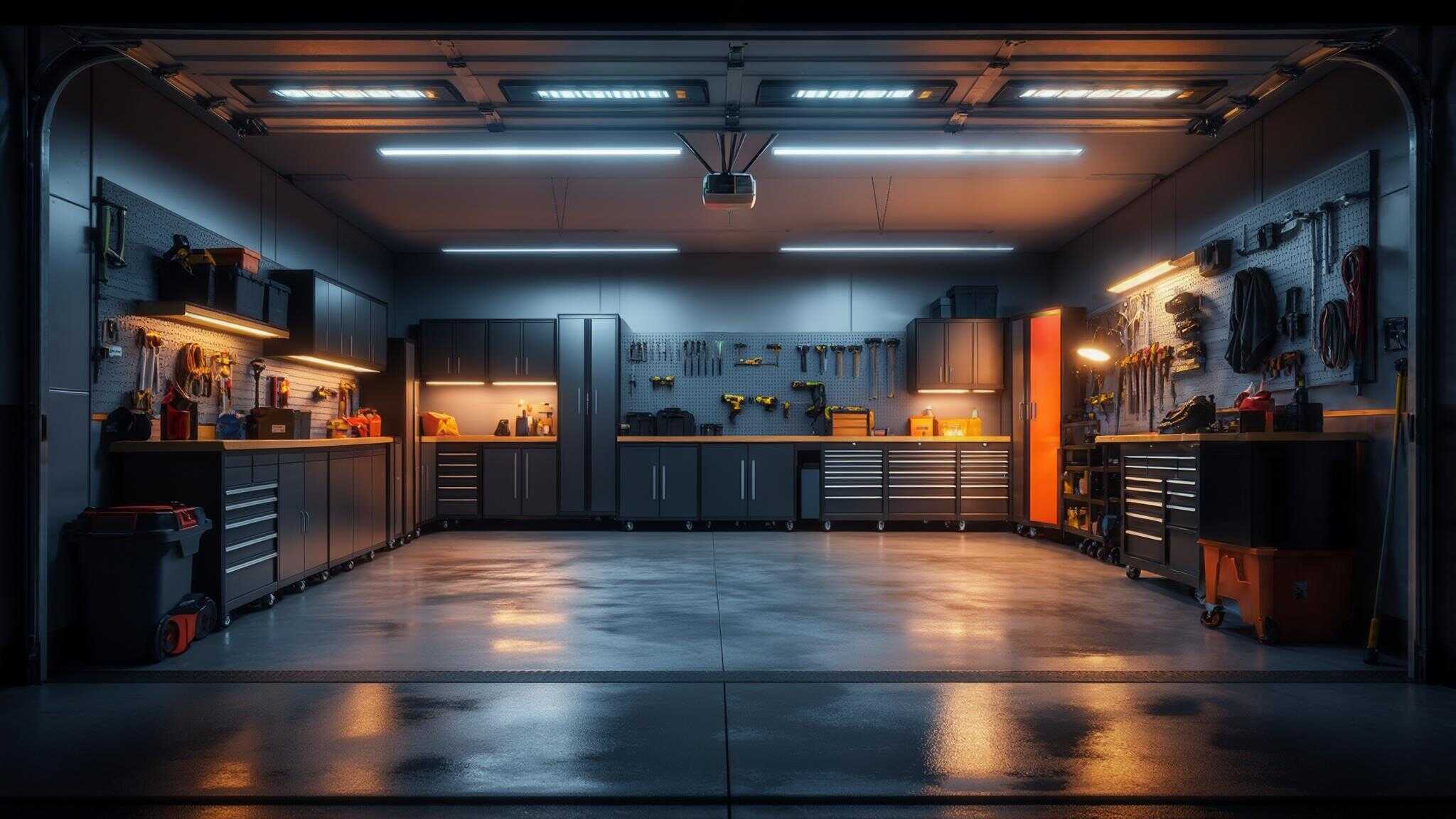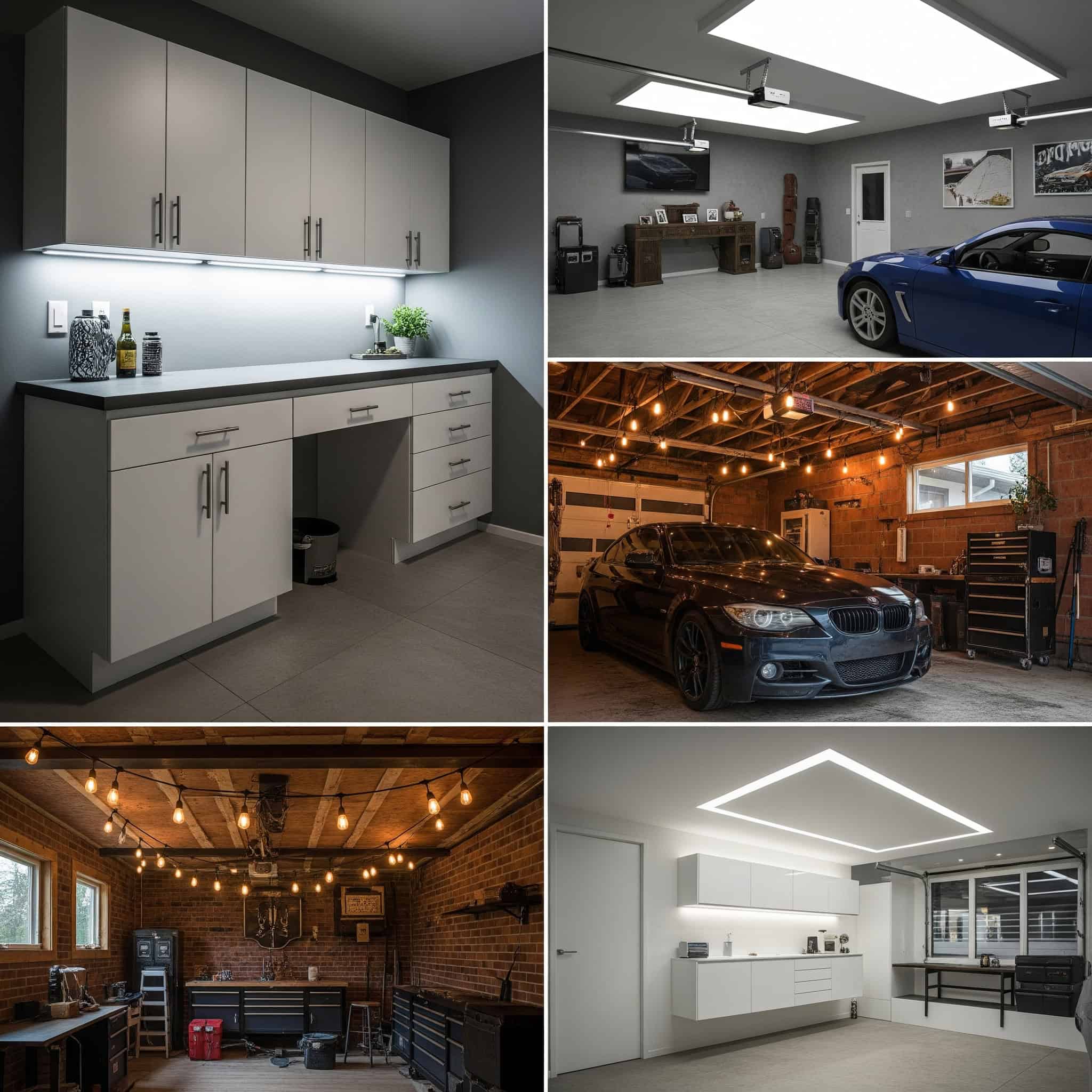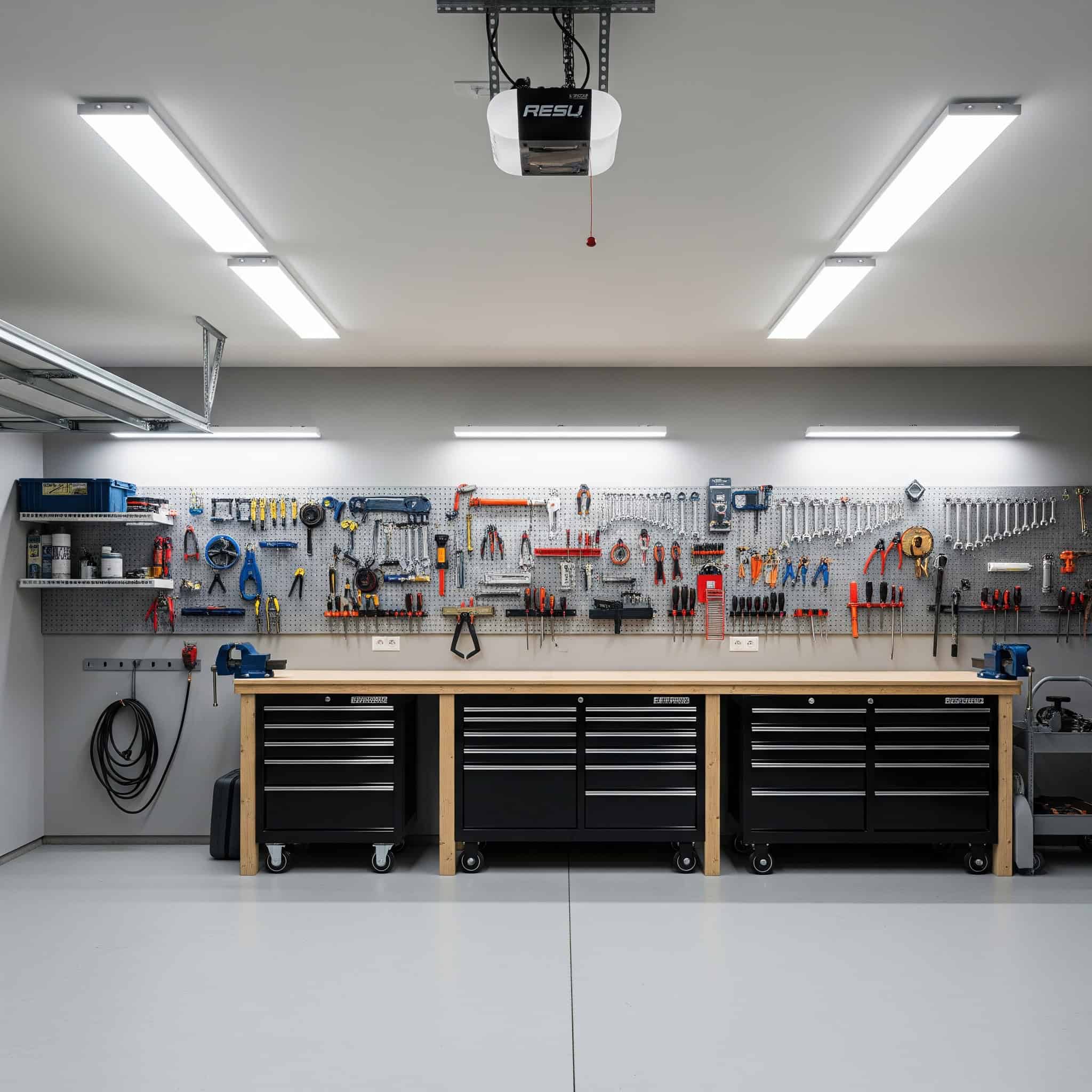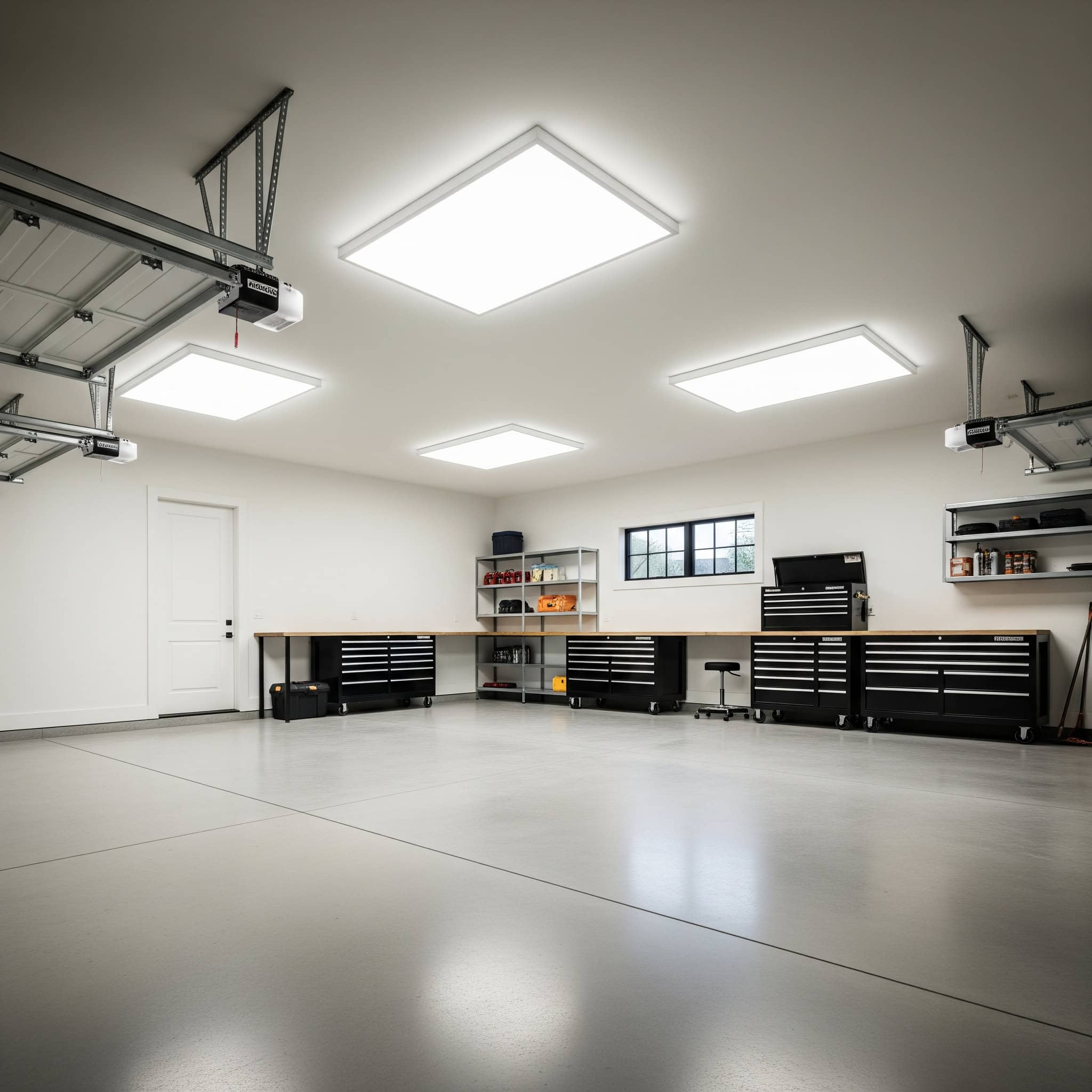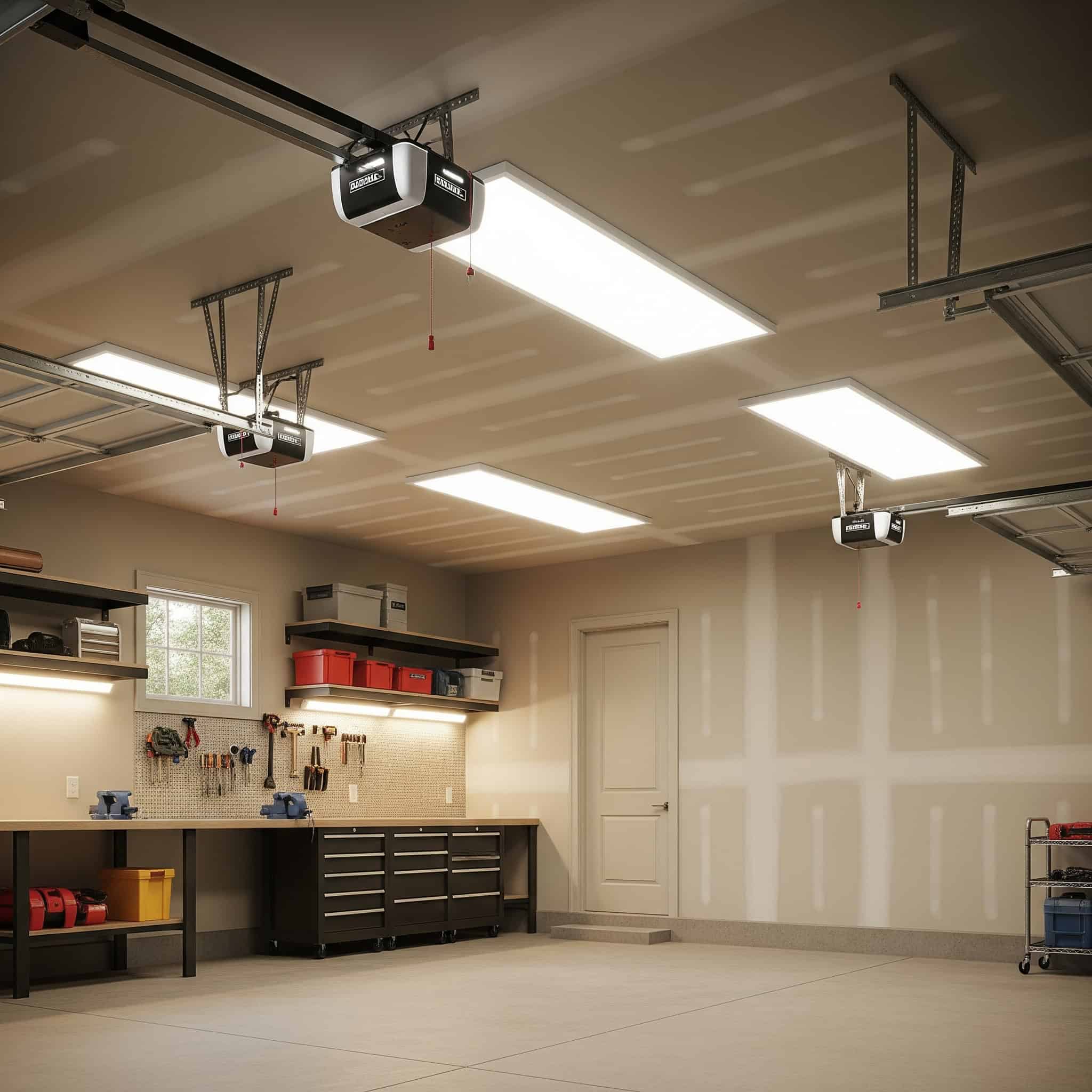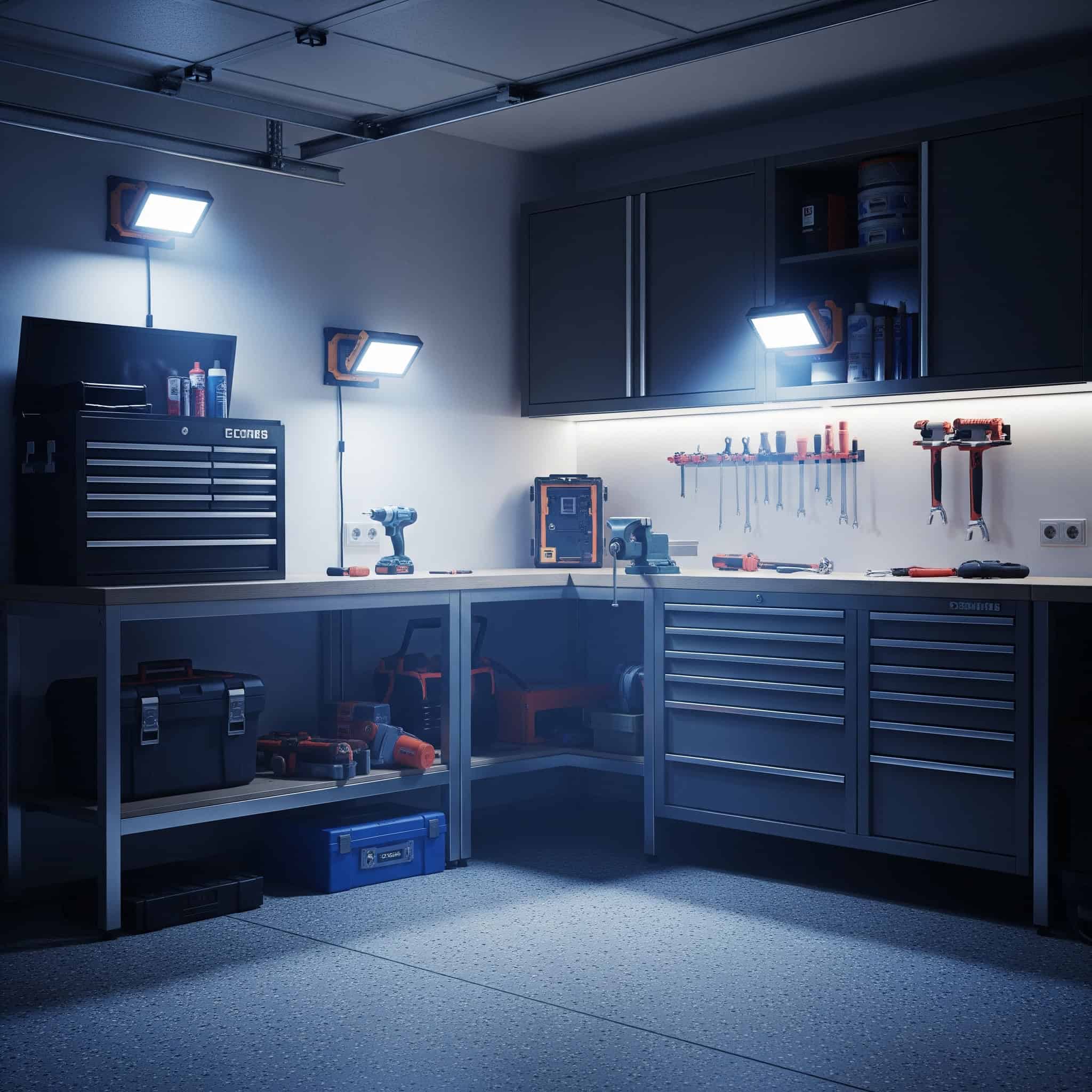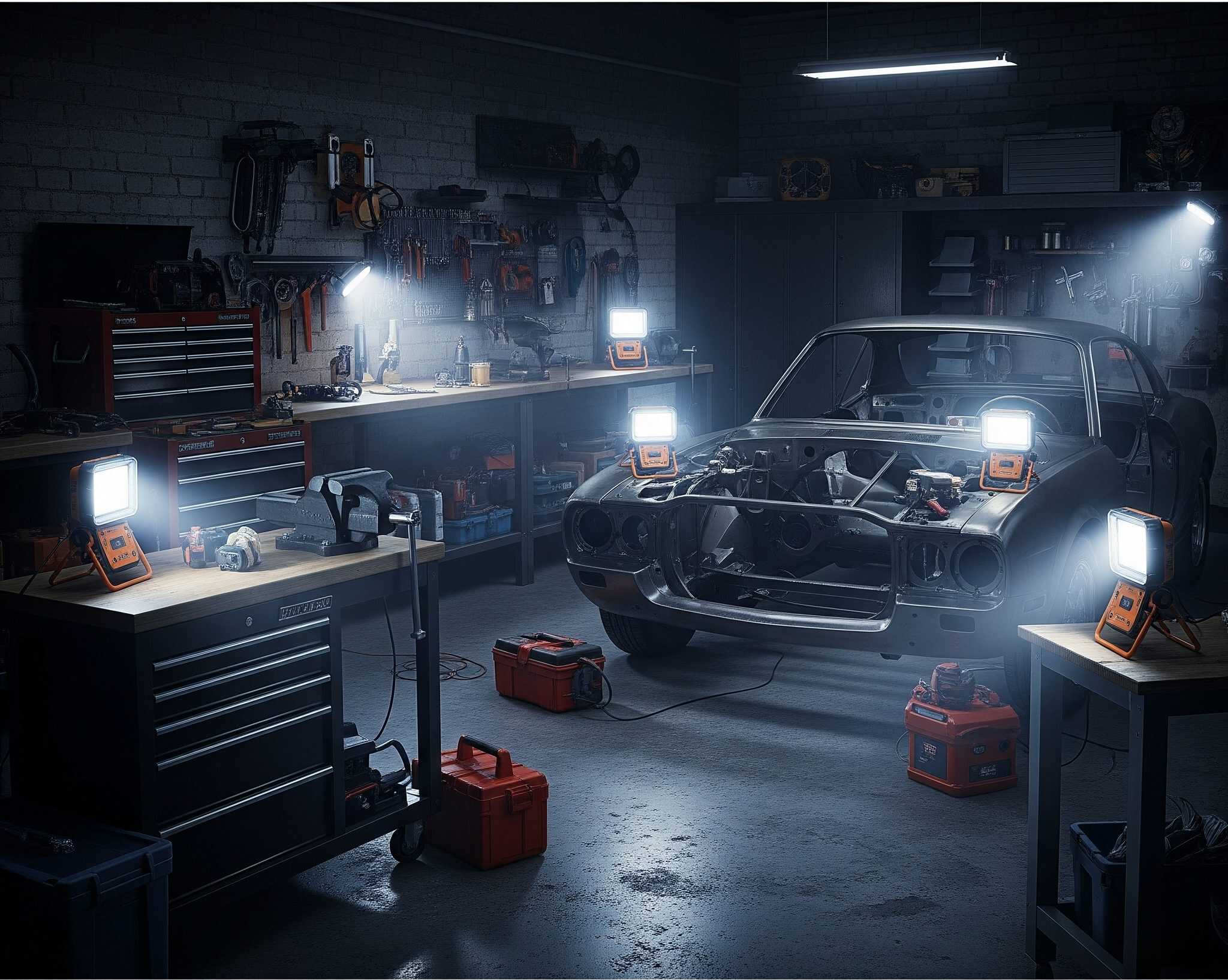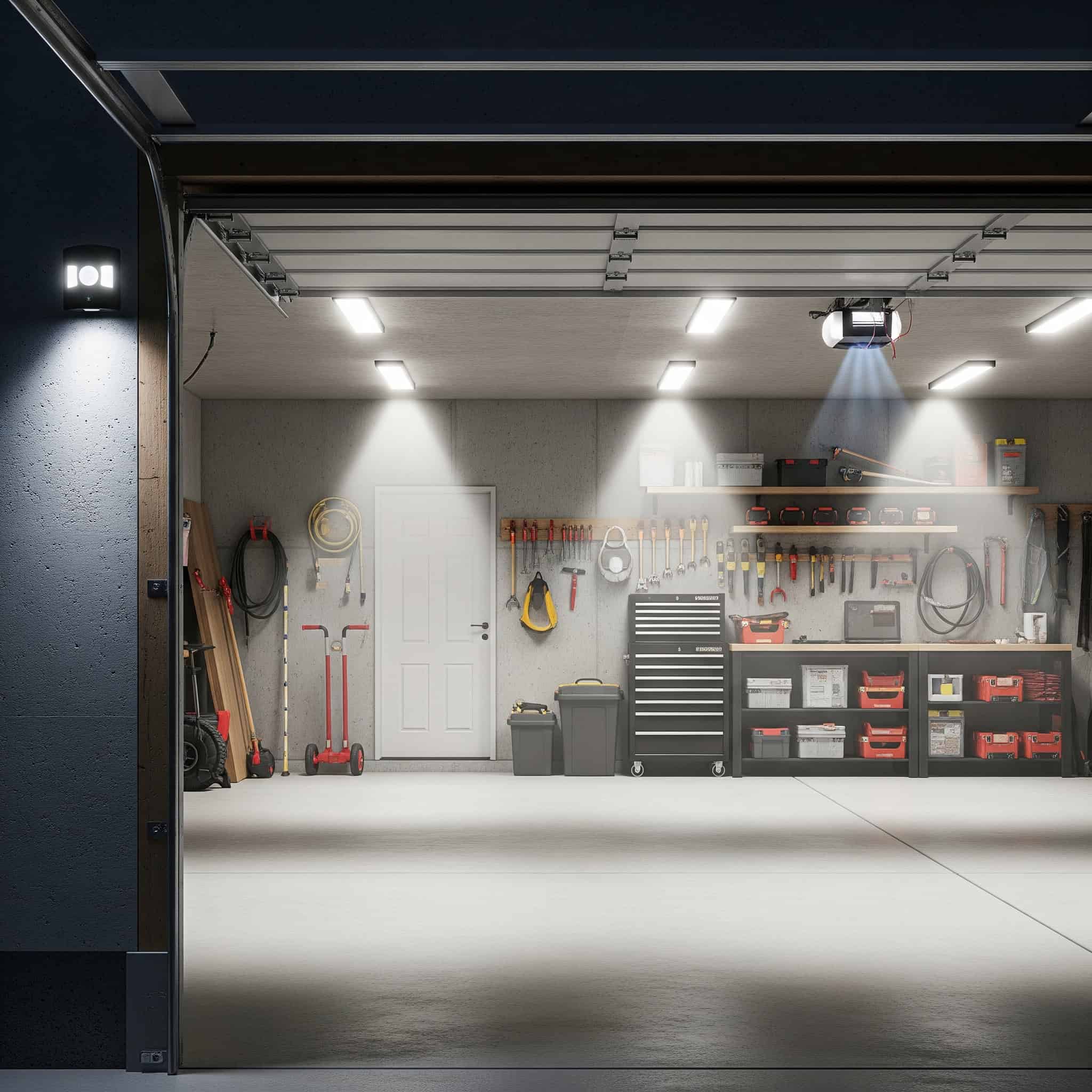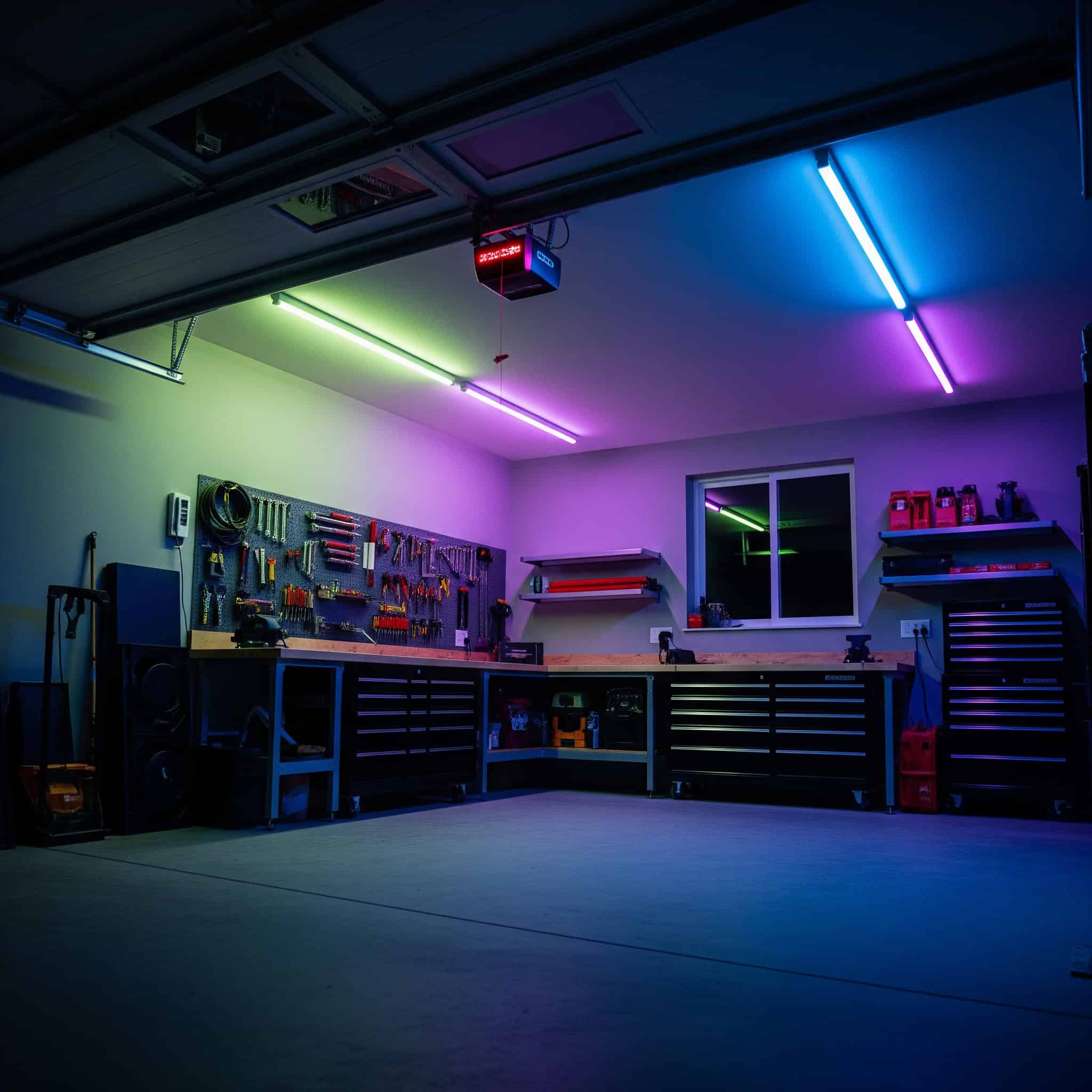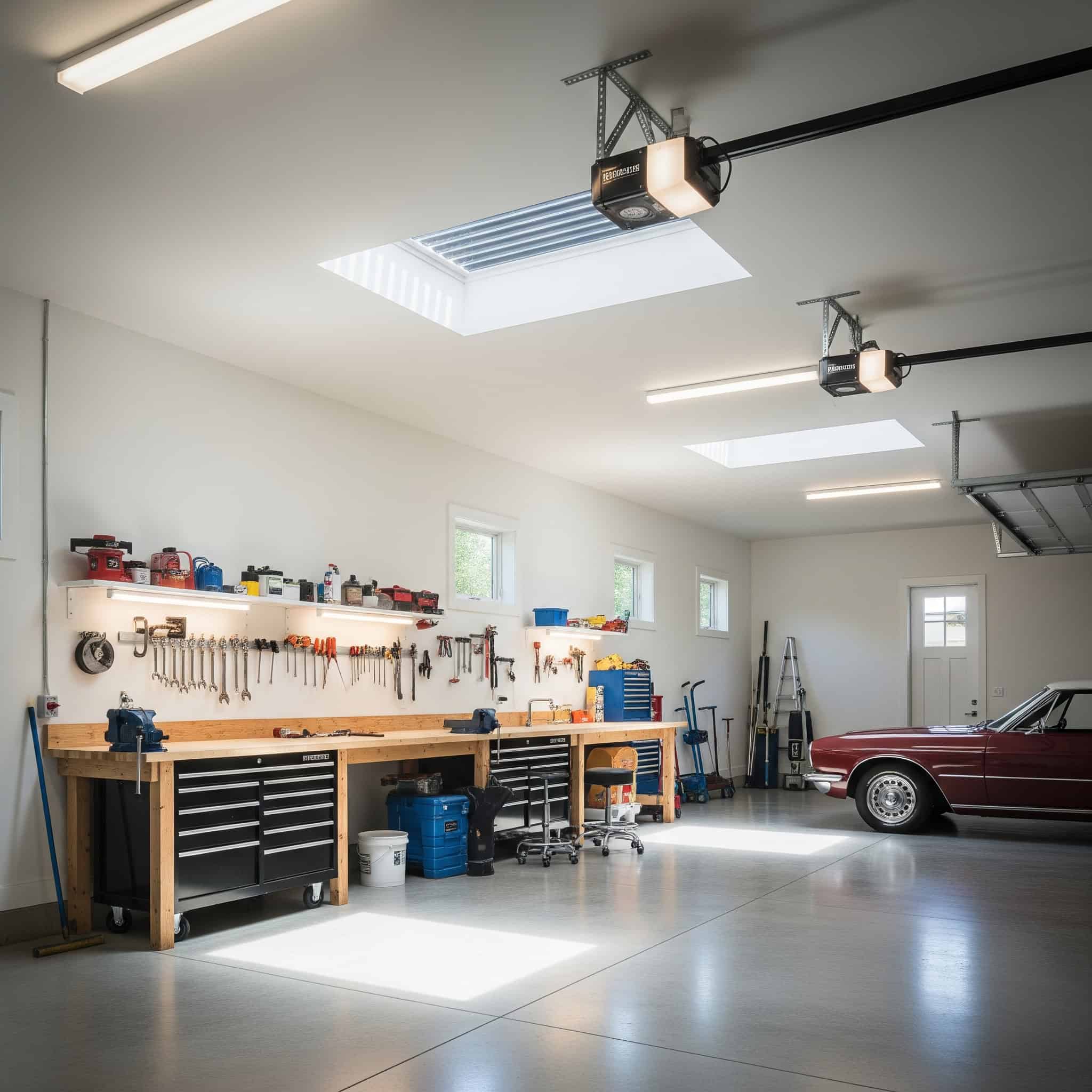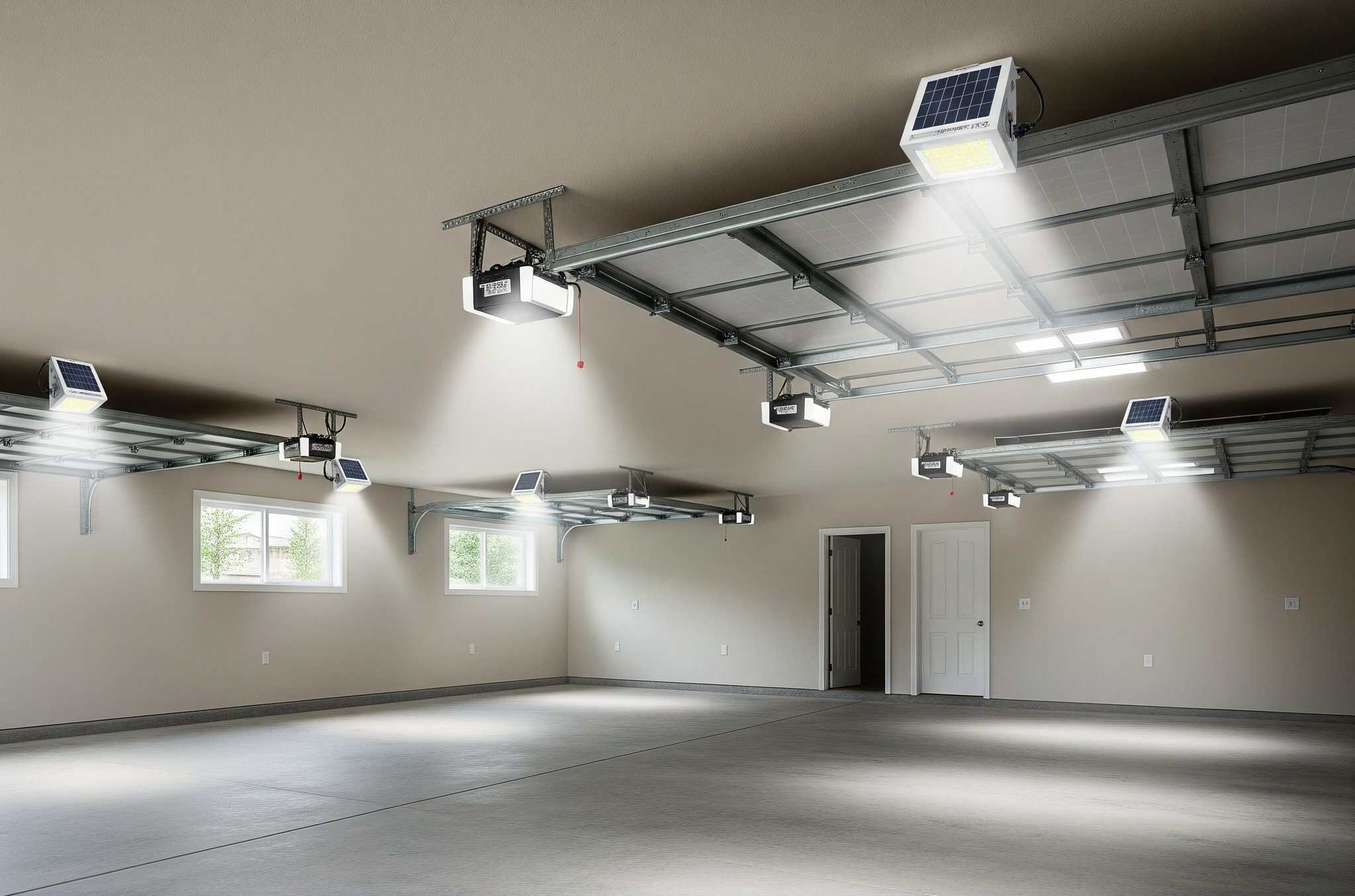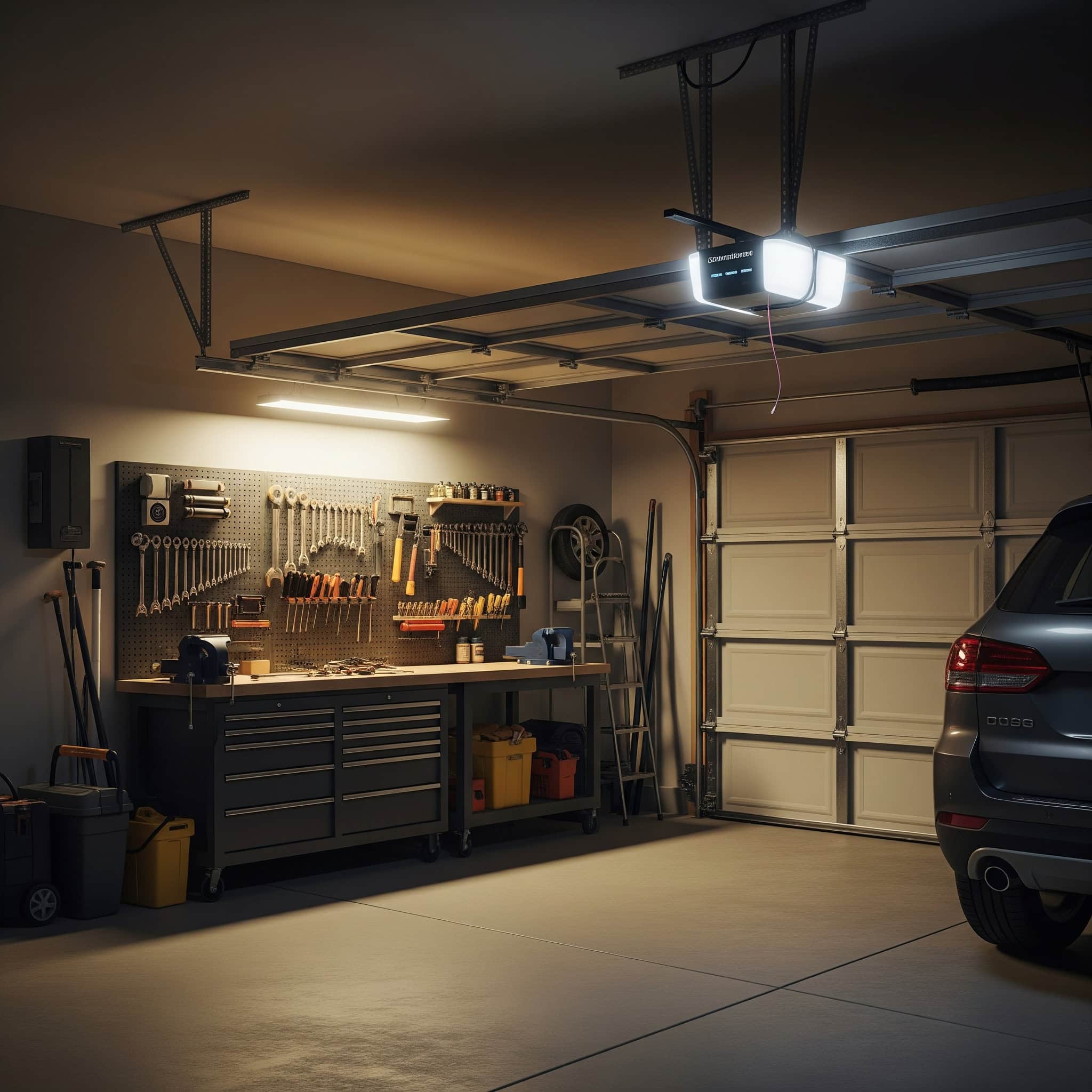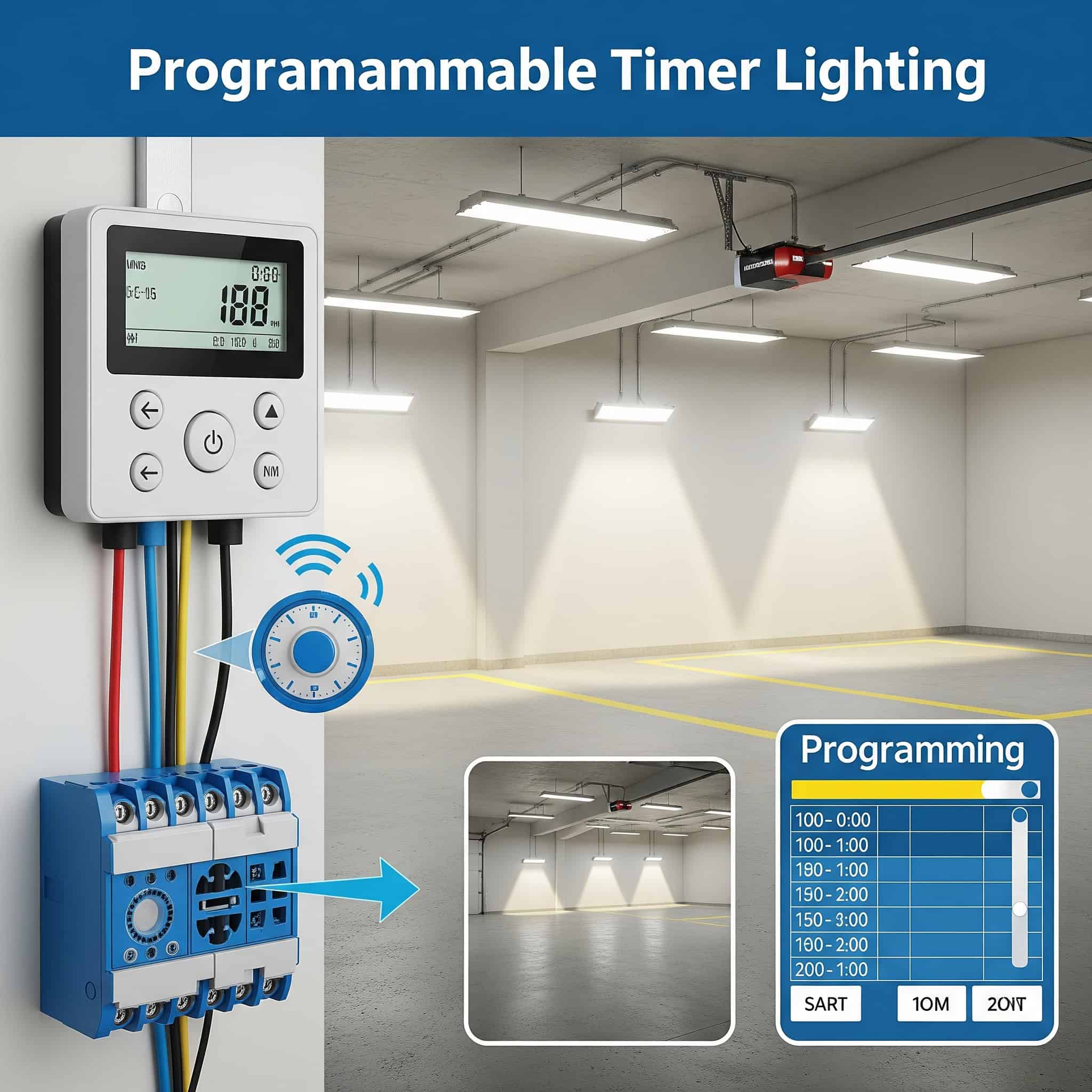25 Ultimate Garage Lighting Ideas for 2025: Transform Your Space from Dim to Dazzling
According to a recent survey by the National Association of Home Builders, 85% of homeowners consider their garage lighting inadequate for their needs. I discovered this firsthand last winter when trying to find my snow shovel in the shadowy corners of my garage. Proper lighting transforms not just visibility but functionality—turning your garage from a dark storage cave into a versatile space for parking, projects, or even a home gym.
The lighting requirements for your garage can vary dramatically depending on how you use the space. If you’re working on detailed projects, you’ll need 2-3 times more lumens per square foot than if you’re just using it for basic storage. This explains why so many garages feel dark and unwelcoming.
Most American garages are significantly underlit—by about 40-60% compared to recommended standards. This lighting deficit not only makes it harder to find things but can create safety hazards when working with tools or moving around in the space.
Table of Contents
-
What to Consider When Choosing Garage Lighting
-
Ceiling-Mounted Lighting Solutions
-
Task-Specific Lighting Options
-
Smart and Automated Lighting Systems
-
Specialized and Decorative Lighting Options
-
Energy-Efficient and Eco-Friendly Solutions
-
How Jiffy Junk Can Help With Your Garage Transformation
-
Final Thoughts
What to Consider When Choosing Garage Lighting
Before diving into specific fixtures, I need to evaluate several key factors that will determine the success of my garage lighting system. The primary purpose of my garage dictates my lighting needs—a workshop requires brighter, more focused illumination than a simple parking space.
Understanding measurements like lumens (brightness) and Kelvins (light temperature) helps me select appropriate fixtures. For optimal visibility in workshop areas, I’ll need 100-150 lumens per square foot, while basic storage areas can function well with 50-80 lumens per square foot.
Light temperature significantly impacts functionality too. I’ve found that 5000-6500K (cool white) enhances detail visibility by up to 40% compared to warm lighting (2700-3000K). This makes a huge difference when I’m working on detailed projects or trying to find small items.
I also need to consider installation complexity, energy efficiency, safety requirements, and control options to create a system that perfectly matches my space and needs.
|
Garage Purpose |
Recommended Lumens/sq.ft |
Ideal Color Temperature |
Fixture Types to Consider |
|---|---|---|---|
|
Basic Storage |
50-80 |
3000-4000K (Neutral) |
LED Shop Lights, Flush Mounts |
|
Parking Only |
70-100 |
4000-5000K (Cool) |
LED Panels, Recessed Cans |
|
Workshop |
100-150 |
5000-6500K (Daylight) |
High Bay LEDs, Task Lights |
|
Multi-purpose |
80-120 |
4000-5000K (Cool) |
Smart Systems, Zone Lighting |
|
Home Gym |
70-100 |
4000-5000K (Cool) |
Vapor-tight, Motion-activated |
Ceiling-Mounted Lighting Solutions
1. LED Shop Lights
LED shop garage lights have become my go-to solution for general garage illumination. These linear fixtures typically measure 4 feet in length and deliver impressive brightness between 4000-5000 lumens per unit. I can install them individually or link multiple units together for comprehensive coverage.
Modern LED shop lights consume approximately 40-60 watts while producing light equivalent to 300-watt traditional fixtures. This results in 80-85% energy savings—a difference I definitely notice on my electric bill.
The linkable feature is particularly useful in my two-car garage, allowing me to daisy-chain up to 8-12 fixtures (depending on model) on a single circuit without requiring additional wiring. Their neutral to cool light temperature (4000-5000K) provides excellent visibility for most garage activities.
2. Recessed Can Lights
Recessed can lights create a clean, streamlined ceiling appearance while providing effective illumination. Typically measuring 4-6 inches in diameter, these fixtures install directly into your ceiling in a grid pattern with 4-6 feet of spacing between units.
Modern LED recessed cans achieve 90+ CRI (Color Rendering Index), providing truer color representation than fluorescent alternatives that typically score 70-80 CRI. This makes a huge difference when I’m working on projects where color accuracy matters.
IC-rated (Insulation Contact) recessed fixtures are required when installed in insulated ceilings to prevent fire hazards and maintain energy efficiency. While they require more complex installation than surface-mounted options, they deliver a polished, finished look that works well in converted garages or spaces that double as living areas.
John, a classic car enthusiast from Portland, transformed his two-car garage into a showroom-quality space using twelve 4-inch recessed LED can lights arranged in a grid pattern. He chose fixtures with a 90° beam angle and 4000K color temperature to provide even illumination across his vehicles without creating harsh reflections on the polished surfaces. The dimmable feature allows him to create a more dramatic atmosphere when showcasing his collection to visitors while still providing full brightness when detailing or maintaining the vehicles.
3. Flush Mount LED Panels
Flat LED panels represent the latest evolution in garage ceiling garage lighting. Available in 1’×4′ or 2’×2′ configurations, these ultra-thin fixtures mount directly to your ceiling surface, providing exceptionally even light distribution without harsh shadows.
Edge-lit LED panel technology uses light guide plates to distribute illumination evenly across the entire surface, eliminating hot spots and reducing eye strain. This makes a huge difference during long project sessions in my garage.
Commercial-grade panels feature driver boxes with 0-10V dimming capabilities, allowing integration with smart home systems for customizable brightness levels. Their modern, minimalist appearance works well in contemporary spaces, while their impressive 50,000+ hour lifespan means I’ll rarely need to replace them.
4. High Bay LED Lights
For garages with high ceilings (9 feet or taller), high bay LED fixtures provide the concentrated, powerful illumination needed to reach your work surfaces. These fixtures come in UFO-style (round) or linear configurations and typically deliver 15,000+ lumens—enough to illuminate even large, high-ceiling spaces effectively.
High bay fixtures typically operate at 100-240V with power factors exceeding 0.95, ensuring efficient operation even in demanding electrical environments. This technical advantage makes them particularly suitable for serious workshop spaces.
Advanced models incorporate specialized optics with beam angle options (60°, 90°, 120°) to customize light distribution based on ceiling height and coverage requirements. If you’re considering high bay LED lights as part of a larger renovation project, you may need to handle disposal of construction debris and concrete junk from ceiling modifications to support these heavier fixtures.
5. Retractable Ceiling Lights
Retractable ceiling garage lights offer unique flexibility by allowing you to adjust the height of your light source based on your current activity. These pull-down fixtures can remain flush with the ceiling when not needed, then extend downward to provide focused illumination for specific tasks.
Retractable systems typically incorporate counterbalance mechanisms rated for 10,000+ cycles, ensuring long-term reliability during frequent height adjustments. I’ve found this particularly valuable when working on different types of projects that require varying light positions.
Advanced models feature integrated heat dissipation systems that maintain LED efficiency even when fixtures are retracted against ceiling surfaces. This adaptability makes them particularly valuable in multipurpose garages where lighting needs change frequently.
Task-Specific Lighting Options
6. Under-Cabinet LED Light Strips
Under-cabinet LED strips have revolutionized my workspace lighting by providing targeted illumination exactly where I need it. These flexible, adhesive-backed strips install easily beneath shelving, cabinets, or workbenches to eliminate shadows and enhance visibility for detailed tasks.
Professional-grade LED strips feature 120-240 LEDs per meter with aluminum channel housing that improves heat dissipation and extends operational lifespan by 30-40%. This makes them a long-term solution rather than a temporary fix.
High-quality strips offer CRI ratings of 95+, providing near-perfect color accuracy critical for detailed work like automotive painting or woodworking. Their low profile makes them virtually invisible when mounted, while their minimal power consumption adds negligible cost to your electricity bill.
7. Magnetic Work Lights
Magnetic work garage lights deliver ultimate positioning flexibility for metal-rich garage environments. These portable LED units attach securely to any ferrous surface—tool cabinets, car frames, steel beams, or equipment—bringing bright illumination precisely where needed.
Industrial-grade magnetic work lights feature neodymium magnets with 25-50 pound pull force, ensuring stable positioning even on vertical surfaces during vibration-heavy tasks. This strong attachment has saved me countless times when working underneath vehicles.
Rechargeable models now incorporate lithium-ion batteries with 4-8 hour run times at full brightness and intelligent power management systems that extend battery life. Available in battery-powered or corded versions, they provide temporary task lighting without permanent installation.
8. Articulating Arm Task Lights
Wall-mounted articulating lights combine permanent installation with positional flexibility. These adjustable fixtures feature multi-jointed arms that extend, retract, and pivot to direct light exactly where needed.
Professional-grade articulating fixtures incorporate friction hinges rated for 10,000+ movement cycles, maintaining position stability even when extended to maximum reach. This reliability is crucial when I’m in the middle of a detailed project.
Advanced models feature integrated heat sinks that maintain LED junction temperatures below critical thresholds, extending diode lifespan to 50,000+ hours. When installing articulating arm lights in your garage, consider a complete garage cleanout service first to ensure you have proper access to walls and workspaces for optimal light placement.
Sarah, a woodworker who specializes in intricate inlay work, installed three articulating arm lights strategically around her garage workbench. Each fixture provides 1,000 lumens of 6000K light with a CRI of 95, allowing her to see fine details and true wood colors. The arms extend up to 43 inches from the wall and can be positioned to eliminate shadows from any angle. When not working on detailed projects, she folds the arms back against the wall to create more space. This setup has dramatically improved her precision work while eliminating the eye strain she previously experienced with inadequate lighting.
9. Portable LED Work Lamps
Free-standing work lamps provide powerful illumination without any installation requirements. These adjustable-height fixtures typically feature tripod or weighted bases that allow placement anywhere in your garage.
Commercial-grade portable work lamps deliver focused illumination with beam angles of 30-60 degrees, concentrating 2000-5000 lumens precisely on work surfaces. I’ve found this concentrated light invaluable when working on detailed mechanical projects.
Advanced models incorporate passive cooling systems that maintain optimal operating temperatures without fans, eliminating noise during detailed work. Their complete portability makes them perfect for temporary projects or changing work areas.
10. Overhead Track Lighting
Track lighting systems combine fixed installation with directional flexibility. These rail-mounted fixtures allow you to position, aim, and adjust multiple garage light heads along a central power track.
Modern track systems support 120V/20A circuits with capacity for 8-12 fixtures per 8-foot section, allowing comprehensive coverage without additional circuit installation. This versatility makes track lighting particularly effective for garages with changing layouts or multiple work zones.
Advanced track heads incorporate precision-engineered reflectors that shape light distribution patterns from narrow spot (15°) to wide flood (60°) for task-specific illumination. While installation requires moderate electrical knowledge, the resulting system provides exceptional adaptability for highlighting specific areas or redirecting light as your needs change.
|
Task Lighting Type |
Mobility |
Installation Complexity |
Best Applications |
Average Cost Range |
|---|---|---|---|---|
|
Under-Cabinet LED Strips |
Fixed |
Low |
Workbenches, Shelving |
$20-$100 per 16ft |
|
Magnetic Work Lights |
Portable |
None |
Vehicle repairs, Metal surfaces |
$30-$120 per unit |
|
Articulating Arm Lights |
Semi-Fixed |
Moderate |
Precision work areas |
$60-$200 per unit |
|
Portable LED Work Lamps |
Fully Portable |
None |
Temporary projects |
$40-$150 per unit |
|
Overhead Track Lighting |
Adjustable |
High |
Multi-zone workshops |
$100-$300 per 8ft track |
Smart and Automated Lighting Systems
11. Motion-Activated Garage Lights
Motion-activated fixtures have completely changed how I enter and use my garage. These ceiling-mounted units automatically illuminate when they detect movement in your garage and turn off after a preset period of inactivity.
Advanced motion sensors utilize passive infrared technology with detection ranges of 20-30 feet and 120-180 degree coverage angles, ensuring activation upon garage entry. This means my lights turn on the moment I step inside, even if my hands are full of groceries or tools.
Sophisticated models incorporate ambient light sensors that prevent daytime activation when natural light provides sufficient illumination, maximizing energy savings. This automation proves particularly valuable when entering with full hands or for security purposes.
12. Smart LED Garage Lighting System
WiFi or Bluetooth-connected garage lighting systems bring comprehensive control to your garage illumination. These networked fixtures connect to smartphone apps that allow remote operation, scheduling, and customization.
Enterprise-grade smart lighting systems operate on mesh network protocols (Zigbee, Z-Wave) that maintain connectivity even when individual nodes fail, ensuring system reliability. This redundancy has proven invaluable during power fluctuations in my area.
Advanced systems incorporate machine learning algorithms that analyze usage patterns and automatically optimize lighting schedules, reducing energy consumption by 15-25%. I can turn lights on before arriving home, create automated schedules, or adjust brightness from anywhere.
13. Voice-Controlled Garage Lighting
Voice-controlled lighting takes smart automation to the next level by integrating with popular voice assistants like Alexa, Google Assistant, or Siri. This hands-free control allows me to adjust my garage light through simple voice commands—particularly valuable when my hands are occupied with tools or projects.
Voice-controlled systems utilize natural language processing with contextual awareness, recognizing complex commands like “dim the workbench lights to 50% but keep the storage area bright.” This level of control feels almost magical when I’m in the middle of a project.
Enterprise-level systems incorporate local processing capabilities that maintain functionality during internet outages, ensuring reliable operation independent of cloud connectivity. While these systems require integration with existing smart home ecosystems, they provide unmatched convenience for frequent garage users who want effortless lighting control.
14. Daylight Harvesting Systems
Daylight harvesting represents the pinnacle of energy-efficient automated lighting. These sophisticated systems use sensors to measure available natural light from windows or skylights, then automatically adjust artificial lighting levels to maintain consistent illumination while minimizing energy use.
Commercial-grade daylight harvesting systems utilize photosensors with logarithmic response curves that accurately measure illuminance levels from 10-10,000 lux, matching human visual perception. This precision ensures I always have optimal lighting without wasting electricity.
Advanced controllers implement proportional-integral-derivative algorithms that smoothly adjust artificial lighting levels without perceptible flickering or abrupt transitions. While installation requires professional expertise, the resulting system maximizes both energy savings and lighting comfort.
15. Occupancy-Based Zone Lighting
Zone lighting systems divide your garage into distinct lighting areas that activate independently based on occupancy. This targeted approach illuminates only the spaces currently in use, maximizing energy efficiency in larger garages.
Professional zone systems incorporate ultrasonic sensors that detect movement through solid objects, ensuring activation even when occupants are partially obscured by vehicles or storage. This technology has proven far more reliable than basic motion sensors in my experience.
Advanced controllers feature programmable time delays (30 seconds to 30 minutes) for each zone, optimizing energy usage based on typical occupancy patterns in different areas. Multiple sensors monitor different zones, activating appropriate fixtures when someone enters a specific area.
|
Smart Lighting Feature |
Energy Savings |
Installation Complexity |
Smart Home Integration |
Approximate Cost Premium |
|---|---|---|---|---|
|
Motion Activation |
20-40% |
Low |
Optional |
$10-$30 per fixture |
|
Smartphone Control |
15-25% |
Moderate |
Required |
$40-$100 per system |
|
Voice Control |
10-20% |
Moderate |
Required |
$50-$120 per system |
|
Daylight Harvesting |
30-60% |
High |
Optional |
$150-$500 per system |
|
Zone-Based Control |
25-45% |
High |
Recommended |
$200-$600 per system |
Specialized and Decorative Lighting Options
16. Vapor-Tight Garage Light Fixtures
Vapor-tight fixtures have been a game-changer in my humid coastal garage. These sealed units resist moisture, dust, and airborne particles that would damage standard fixtures, making them ideal for humid climates or workshops generating significant dust.
Industrial-grade vapor-tight fixtures achieve IP65-IP67 ratings, protecting internal components from water jets and dust ingress in demanding environments. This protection has kept my lights functioning perfectly even during the most humid summer months.
High-performance models incorporate silicone gaskets and polycarbonate lenses that maintain seal integrity through temperature fluctuations from -20°F to 120°F. Their durable construction ensures consistent performance even in harsh conditions.
17. Color-Changing LED Garage Lights
RGB LED fixtures add both functionality and aesthetic flexibility to your garage lighting. These color-changing units allow you to select different light colors via remote control or smartphone app—white for working, red for nighttime visibility that preserves dark adaptation, or decorative colors for entertaining.
Professional RGB systems utilize PWM (Pulse Width Modulation) at 25kHz+ frequencies, eliminating visible flicker even when captured on high-speed cameras during automotive photography. This technical advantage makes them suitable for more than just decorative purposes.
Advanced controllers support 16-million color combinations with gamma correction that ensures color accuracy across brightness levels from 10-100%. While primarily chosen for their visual appeal, the ability to customize light color also serves practical purposes in multipurpose garage spaces.
18. Vintage-Style Edison Bulb Fixtures
Industrial-look fixtures with exposed filament bulbs bring distinctive style to garage spaces. These vintage-inspired units emphasize aesthetics while providing moderate illumination, making them best suited for supplemental lighting rather than primary task illumination.
Modern Edison-style LED filaments achieve 15-25 lumens per watt efficiency (compared to 2-3 lumens per watt in traditional incandescent versions) while maintaining authentic appearance. I’ve installed several of these fixtures in my garage lounge area for a warm, inviting atmosphere.
Quality vintage fixtures incorporate dimmable drivers with minimum loads of 10%, allowing brightness adjustment without the flickering common in lower-quality alternatives. Their simple installation process typically involves basic surface mounting, while their affordable price point makes them an accessible option for adding visual interest to well-lit garage environments.
19. Solar Tube Skylights
Solar tubes have transformed my daytime garage experience by channeling natural sunlight into the space without the complexity of traditional skylights. These roof-mounted tubes capture daylight through dome collectors, then direct it through reflective tubing into your garage space.
High-performance solar tubes achieve effective transmittance of 99.7% per foot of tubing length, delivering up to 98% of captured light even through 20+ feet of reflective channeling. This efficiency means I get bright, natural illumination even on partially cloudy days.
Advanced dome designs incorporate prismatic diffusers that distribute daylight evenly throughout spaces up to 300 square feet from a single 10-14 inch diameter tube. Professional installation is required, but the long-term energy savings and quality of natural light make solar tubes an excellent investment for day-use garages.
Mike, a homeowner in Arizona, installed two 14-inch diameter solar tubes in his three-car garage, which completely transformed the space during daylight hours. The tubes cost $600 each plus $800 for professional installation, but eliminated the need for daytime electric lighting entirely. The specialized diffusers spread natural sunlight evenly throughout the 700 square foot space, achieving illumination levels of 120-150 lumens per square foot on clear days—exceeding what his previous electrical system provided. The payback period was just under 4 years based on energy savings, and the improved color rendering of natural light has made his weekend automotive projects much more enjoyable.
20. Integrated Ceiling Fan with Lights
Combination fan/light units provide dual functionality in a single installation. These fixtures improve air circulation while delivering effective illumination—particularly valuable in garages without adequate ventilation.
Industrial-grade integrated units feature DC motors with 6-9 speed settings that consume 70% less electricity than AC alternatives while operating at lower noise levels (35-45dB). This efficiency has made a noticeable difference in both my comfort level and energy bills.
Advanced models incorporate sealed light compartments with separate circuitry from fan components, preventing dust accumulation on optical surfaces and maintaining light output. When upgrading to an integrated ceiling fan with lights, you might need to consider proper disposal of old electrical fixtures to ensure they’re recycled correctly rather than ending up in landfills.
Energy-Efficient and Eco-Friendly Solutions
21. Solar-Powered Garage Lights
Self-contained solar lighting units have eliminated my need for additional electrical work in certain areas of my garage. These fixtures incorporate small solar panels that charge internal batteries during daylight hours, then power LED lights when needed.
High-capacity solar fixtures incorporate lithium-ion batteries with 2000-3000mAh capacity, providing 8-12 hours of illumination after a single day of charging. This reliability means I never have to worry about power outages affecting my basic garage lighting.
Advanced models feature monocrystalline solar panels with 22-24% efficiency ratings, generating sufficient power even during partial cloud cover or indirect sunlight. After installing solar-powered garage lights, many homeowners look into additional eco-friendly improvements for their property, creating a more sustainable living environment overall.
22. Ultra-Efficient T8 LED Tube Replacements
LED tubes that replace fluorescent bulbs in existing fixtures offer an easy efficiency upgrade. These direct replacement tubes install in standard fluorescent fixtures but consume significantly less energy while providing better light quality and longer lifespan.
Professional-grade T8 LED replacements achieve efficacy ratings of 160-180 lumens per watt, more than double the efficiency of standard fluorescent tubes (60-80 lumens per watt). This dramatic improvement has cut my garage lighting electricity usage by more than half.
Advanced tubes feature internal drivers with surge protection up to 4kV, preventing premature failure during power fluctuations common in detached garage installations. The simple retrofit process requires no electrical modifications for most installations, making this one of the most accessible efficiency upgrades for garages with existing fluorescent lighting systems.
23. Garage Door Opener Integrated Lighting
Modern garage door openers incorporate enhanced LED garage lighting systems that provide effective general illumination. These built-in lights activate automatically when you operate your door and can typically be controlled independently as well.
Premium opener systems feature 100+ CRI LED arrays that provide true color representation, improving visibility compared to the 60-70 CRI common in basic opener lights. This color accuracy makes a noticeable difference when I’m looking for specific items in my garage.
Advanced models incorporate directional light panels that focus illumination downward at 120-degree beam angles, maximizing useful light on garage floors and vehicle surfaces. Since the lighting comes integrated with your opener, installation requires no additional electrical work.
24. Light Reflectors and Amplifiers
Strategic use of reflective surfaces has dramatically improved my garage lighting without adding a single new fixture. White ceiling paint increases light reflection by 80-90% compared to unfinished surfaces, while specialized reflective panels can direct and amplify light where needed most.
Commercial-grade reflective ceiling paint achieves light reflectance values (LRV) of 85-92%, effectively increasing apparent brightness by 25-35% compared to standard white paint (75-80% LRV). This simple upgrade made my entire garage feel brighter and more welcoming.
Professional reflector panels incorporate micro-prismatic surfaces that redirect light with minimal diffusion, concentrating illumination on work surfaces with 95%+ efficiency. This approach maximizes the effectiveness of your current fixtures through simple, cost-effective modifications to your garage surfaces rather than electrical system changes.
25. Programmable Timer-Based Lighting
Timer-controlled lighting systems automatically adjust based on time of day, ensuring your garage is properly illuminated when needed while conserving energy during unused periods. These systems can be programmed for consistent schedules or adjusted seasonally to account for changing daylight hours.
Advanced timer systems incorporate astronomical functions that automatically adjust to seasonal daylight changes based on geographical coordinates, maintaining optimal schedules year-round. This “set it and forget it” functionality has eliminated the need for me to manually adjust my garage lighting throughout the year.
Enterprise-grade controllers feature power monitoring with usage reporting, allowing analysis of consumption patterns and identification of additional efficiency opportunities. The moderate installation complexity typically involves replacing standard switches with programmable alternatives or adding control modules to your electrical system.
How Jiffy Junk Can Help With Your Garage Transformation
Before installing your new garage lighting ideas system, creating a clean, clutter-free environment maximizes both safety and effectiveness. Jiffy Junk specializes in comprehensive garage cleanouts that prepare your space for improvement projects.
Their professional assessment process identifies potential electrical hazards and structural issues that might impact lighting installation, preventing costly complications. I learned this firsthand when their team spotted some questionable wiring during my garage cleanout that could have caused problems with my new lighting system.
Their comprehensive removal service includes disposal of hazardous materials like old fluorescent tubes containing mercury, ensuring proper handling according to EPA guidelines. For homeowners looking to completely transform their garage, efficient and ethical garage junk removal services can clear the way for your new lighting installation while ensuring responsible disposal of old materials.
Final Thoughts
Transforming your garage lighting delivers benefits far beyond basic visibility. Properly illuminated spaces become more functional, safer, and more enjoyable to use. Whether you choose simple LED replacements or comprehensive smart systems, the investment pays dividends through improved productivity, reduced energy costs, and enhanced property value.
Research indicates properly illuminated garages increase property values by 1-3% while reducing home insurance premiums through decreased accident and security risk. This makes lighting upgrades one of the most practical garage improvements you can make.
Comprehensive lighting upgrades typically achieve ROI within 2-4 years through energy savings, with LED systems reducing garage lighting electricity consumption by 60-80%. Start by assessing your specific needs and budget, then implement a lighting plan that combines appropriate fixture types for your unique space. Remember that effective garage lighting often combines multiple approaches—ceiling fixtures for general illumination, task lighting for work areas, and specialized options for particular needs.
